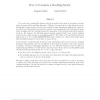Free Online Productivity Tools
i2Speak
i2Symbol
i2OCR
iTex2Img
iWeb2Print
iWeb2Shot
i2Type
iPdf2Split
iPdf2Merge
i2Bopomofo
i2Arabic
i2Style
i2Image
i2PDF
iLatex2Rtf
Sci2ools
CORR
2007
Springer
2007
Springer
How to Complete a Doubling Metric
In recent years, considerable advances have been made in the study of properties of metric spaces in terms of their doubling dimension. This line of research has not only enhanced our understanding of finite metrics, but has also resulted in many algorithmic applications. However, we still do not understand the interaction between various graph-theoretic (topological) properties of graphs, and the doubling (geometric) properties of the shortest-path metrics induced by them. For instance, the following natural question suggests itself: given a finite doubling metric (V, d), is there always an unweighted graph (V , E ) with V ⊆ V such that the shortest path metric d on V is still doubling, and which agrees with d on V . This is often useful, given that unweighted graphs are often easier to reason about. A first hurdle to answering this question is that subdividing edges can increase the doubling dimension unboundedly, and it is not difficult to show that the answer to the above que...
CORR 2007 | Education | Metric | Metric Space | Unweighted Graph |
| Added | 13 Dec 2010 |
| Updated | 13 Dec 2010 |
| Type | Journal |
| Year | 2007 |
| Where | CORR |
| Authors | Anupam Gupta, Kunal Talwar |
Comments (0)

